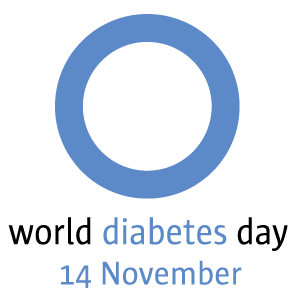World Diabetes Day is celebrated annually on November 14 to acknowledge global awareness of diabetes. It was initiated in 1991 by the International Diabetes Federation and the World Health Organization in response to increased rates of diabetes around the world.
Although the entire month is considered “Diabetes Awareness Month”, the actual World Diabetes Day – November 14 – was chosen because it was Frederick Banting’s birthday. Frederick Banting, along with Charles Best, conceived an idea that eventually led to the discovery of insulin in 1921 and changed the future treatment of diabetes. Diabetes treatment has tremendously evolved since 1991.
I wanted to mention a few of the latest innovations helping to improve diabetes care. We have so much to be thankful for in the field of diabetes treatment as progress is continually being made. There will be even more exciting discoveries in the near future.
- DexCom, which already offers CGM (continuous glucose monitoring), has come up with another helpful product for people who want constant information about their blood sugars to get to their health care provider immediately. The original DexCom gave the patient blood sugar trending numbers about every 5 minutes by placing a sensor into the interstitial fluid; the sensor speaks to a hand held device which shows graphs and important data. Although it is still necessary to do finger sticks for calibration and comparison, the CGM is an excellent tool for people who have extreme highs and lows. It offers trends, estimates and early warning signals. The new DexCom Smart remotely monitors blood glucose levels via the smart system using an Apple iPhone or iPod Touch. It recently won FDA approval and can wirelessly send information to up to 5 smart phones with its Platinum G4 CGM. More decisions can be made instantly with the immediate information sent to your health care provider. This information can hopefully reduce the risks of future complications of diabetes by adjusting medical management quickly.
- Smart phone apps. Most people use apps for games and entertainment, but many apps can offer concrete help in maintaining diabetes control. Apps can track calorie intake, sleep patterns, fitness schedules, blood sugar numbers and management of your medications. A review of “16 clinical trials found that patients using computer or phone based diabetes management tools seemed to improve blood glucose control”. Certain patients are still more comfortable using pen and paper documentation, while others are thrilled with the latest technology. In the end, technology seems to be a real time saver. Popular and often used apps that may be helpful to you are: Diabetes Pal, My Sugr, Glucose Buddy, My Net Diary, My Fitness Pal, Pocket Yoga, Med Coach, Calorie King or Fooducate. Although these apps can be helpful, they should never replace the face to face visit with your health care provider. You can discuss with your physician which they may recommend, as an added diabetes coach and tool. Patients usually look for free apps, or those which offer a free trial period. Look on sites for user reviews and comments. Search for apps that have a social interactive aspect as well. This can offer great support. A very popular diabetes App called GoMeals can do multiple things – including follow blood sugars, exercise and meal tracking.
- Tiny ear buds. These ear buds can track your heart rate during exercise while you still listen to your music. It doses this by sensing your pulse from blood rushing through your ears. Your heart rate is sent directly to your smart phone during the workout so you can pace accordingly. There are a few brands on the market, but the LG Heart Rate Monitor received good reviews. The cost is approximately $180. It has been shown that maintaining a training heart rate – especially during interval training – can aid with fat loss and improved cardiac endurance.
- Patch Pumps. These pumps are specifically used for people with diabetes type 2. The Valeritas V-Go is already approved and on the market, with others making progress in the FDA system. It is much simpler than a regular pump and comes with pre-filled insulin. This allows for a continuous basal infusion, with a button for bolus insulin before a meal. It is a combination pump/insulin pen. The infusion set is replaced every 24 hours. It is an option for those who are supposed to inject insulin 4-6 times a day and do not want to stick themselves that frequently. The patch pump system is prescribed by your physician and usually covered by health insurance.
- Memory Pens. These are already available in unit increments and now will be available in half-unit increments, which is especially helpful for the pediatric population. These pens allow you to check how much insulin you previously took and how long ago it was taken. It helps those who often forget if they have already injected. The product is called Novo Pen Echo, and is made by Novo Nordisk.
- Affrezza. This was recently approved in 2014 and is ultra rapid inhaled insulin. It is taken at the beginning of a meal since it works in 15 minutes. It peaks in 60 minutes and the duration is 3 hours. That is why it needs to be taken prior to each meal. Food must follow, as with injected insulin or hypoglycemia can occur. It comes in pre-measured single use cartridges, and is used with an inhaler device. It is approved for those over 18, those with type 2 diabetes and for people with type 1 diabetes who also use basal insulin. Affrezza is not suggested for those with lung disease, asthma, lung cancer or for those who smoke.
- Biodel glucagon device. A new glucagon device has been created which simplifies the existing glucagon injection. It should make FDA approval in February 2015. Glucagon is a subcutaneous injection used for severe hypoglycemia when a patient is unresponsive and cannot eat or drink. It causes glucose production in the liver, which helps raise the blood sugar and reverse hypoglycemia. The new injection quickly mixes the powder and solution with a simple twist. The needle also retracts after the injection is given. This will be a wonderful product for those with type 1 diabetes or those with hypoglycemic unawareness. Make sure to teach someone how to administer this before a crisis situation.
The list goes on and on, and you will hopefully continue to read about all the latest products and developments in the field of diabetes. Remember, even with all this new technology, you still have to stay active in your own care and practice good lifestyle habits including exercise, following an eating plan and taking your medication correctly. Celebrate progress today!
NOTE: Consult your Doctor first to make sure my recommendations fit your special health needs.







Leave A Comment